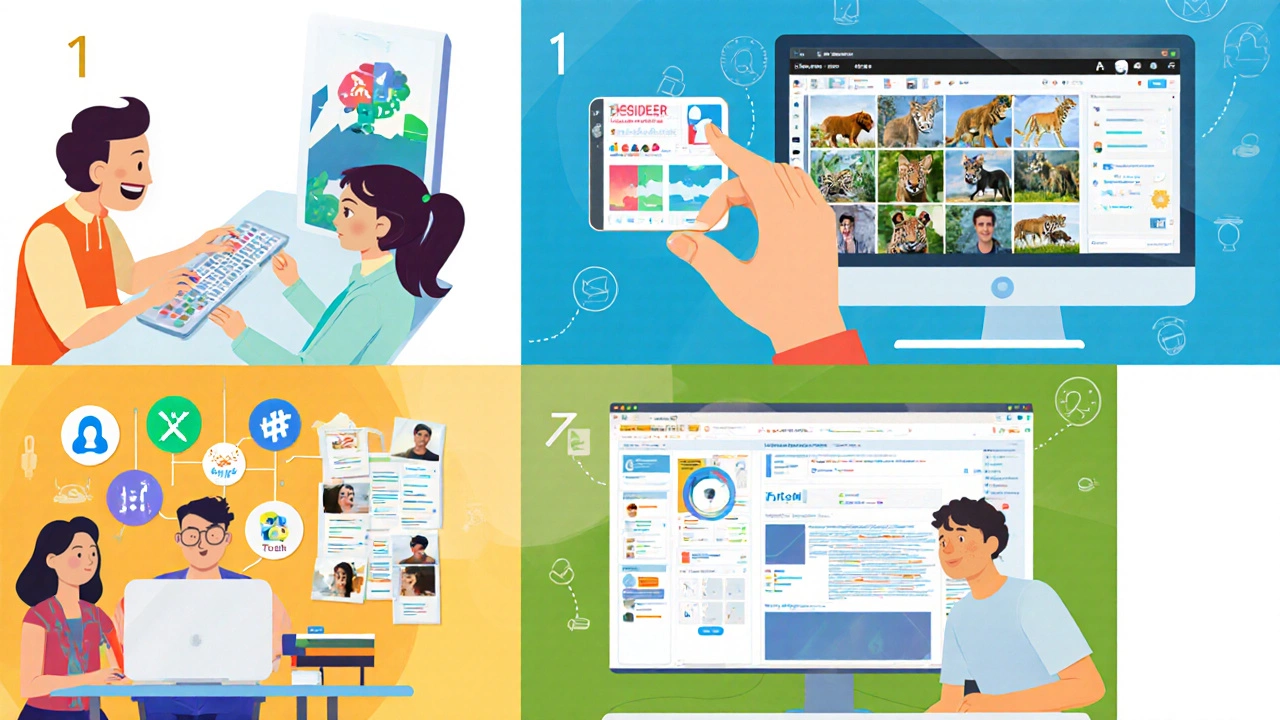When people talk about virtual volunteering is a form of volunteering that takes place entirely online, letting volunteers share time, skills, or resources without ever leaving home. The rise of broadband, collaboration apps, and global crises like the COVID‑19 pandemic have turned this once‑niche idea into a mainstream way to help. If you’ve ever wondered how you can make a difference from your couch, you’re in the right spot.
Key Takeaways
- Virtual volunteering connects volunteers to NGOs through digital platforms and remote tools.
- It includes everything from micro‑tasks to long‑term mentorship programs.
- Flexibility, skill‑matching, and lower overhead are its biggest strengths.
- Challenges include digital exclusion, time‑zone coordination, and measuring impact.
- Getting started is as easy as signing up on a reputable platform and offering a specific skill.
What Exactly Is Virtual Volunteering?
At its core, virtual volunteering is volunteering that happens over the internet. Instead of handing out food packets on the street, a volunteer might translate documents for a refugee‑support NGO, design a website for a charity, or mentor a student via video call. The activity can be one‑off or ongoing, paid or unpaid, but the common thread is the lack of physical presence.
Why It Matters: Benefits for Volunteers and Organizations
For volunteers, the biggest draw is flexibility. You can fit a task into a lunch break, a commute, or a weekend. You also gain access to global causes that align with your passions, even if there’s no local chapter nearby. Additionally, many virtual roles are skill‑based, meaning you can sharpen professional abilities while doing good.
For NGOs, virtual volunteers expand the talent pool beyond geographic limits and reduce costs tied to office space, training, and travel. A small environmental group can tap into a worldwide network of data analysts, graphic designers, or social‑media strategists without a single extra rent bill.
Types of Virtual Volunteering
Not all online help looks the same. Here are the most common formats you’ll encounter:
- Skills‑based volunteering: Professionals donate their expertise-like legal advice, coding, or marketing-to solve specific challenges.
- Microvolunteering: Tiny, bite‑size tasks that take minutes, such as tagging photos for a wildlife database or answering a quick survey.
- Virtual mentorship: One‑on‑one guidance via video, chat, or email, often for youth, entrepreneurs, or patients navigating health systems.
- Remote collaboration projects: Longer‑term commitments where volunteers work together using remote collaboration tools like Slack, Trello, or Google Workspace.
- Digital advocacy: Writing letters to policymakers, managing online petitions, or running social‑media campaigns.

Popular Platforms Connecting Volunteers and Causes
Finding a reputable digital platform is the easiest way to start. Below is a quick snapshot of the most trusted sites (as of 2025):
| Platform | Core Focus | Typical Tasks | Fee Structure |
|---|---|---|---|
| VolunteerMatch | Broad nonprofit network | Mentoring, design, research | Free for volunteers |
| Catchafire | Skills‑based projects | Strategy, IT, marketing | Free for volunteers, NGOs pay a fee |
| Zooniverse | Crowdsourced research | Data tagging, image classification | Completely free |
| UN Volunteers Online | Global development | Policy research, translation | Stipends for longer commitments |
How to Choose the Right Virtual Volunteering Opportunity
Before you dive in, ask yourself these practical questions:
- What skills do I want to use or develop?
- How many hours per week can I realistically commit?
- Do I prefer one‑off tasks or a long‑term partnership?
- Am I comfortable communicating across time zones?
- What impact measurement does the organization provide?
Answering honestly will narrow the field. If you’re a graphic designer looking for a few quick projects, microvolunteering sites like Zooniverse or the short‑term task boards on VolunteerMatch are perfect. If you seek a mentorship role, explore UN Volunteers Online or the dedicated mentorship sections on Catchafire.
Measuring Impact: From Numbers to Stories
One criticism of remote help is the difficulty of proving real‑world results. Effective NGOs employ impact measurement frameworks that track metrics such as hours contributed, tasks completed, and downstream outcomes (e.g., a translated legal guide reaching 5,000 refugees). Look for organizations that publish regular impact reports or provide volunteers with dashboards showing progress.

Common Challenges and How to Overcome Them
Digital exclusion: Not everyone has reliable internet. Some platforms offer offline‑first tools or allow volunteers to download tasks and upload results later.
Time‑zone coordination: Use calendar integrations and set clear expectations about response windows. Tools like World Time Buddy help schedule meetings that suit both parties.
Maintaining motivation: Without face‑to‑face interaction, it’s easy to feel disconnected. Join volunteer forums, share weekly updates, and celebrate small wins to stay engaged.
Step‑by‑Step Guide to Start Your First Virtual Volunteer Role
- Identify your passion and skill set. Write down 2‑3 areas you’re most comfortable with (e.g., writing, data entry, tutoring).
- Create a concise profile on a reputable platform. Highlight relevant experience and upload a short video introduction if possible.
- Browse listed opportunities. Filter by skill, time commitment, and cause.
- Apply or claim the task. Tailor your application to show how your specific abilities meet the project’s needs.
- Set up your workspace: reliable internet, a quiet spot, and the required remote collaboration tool (e.g., Zoom, Slack).
- Complete the onboarding materials, ask clarifying questions, and set milestones with the organization.
- Deliver your work, submit any required reports, and request feedback for future improvement.
Following these steps will turn the abstract idea of virtual volunteering into a concrete, rewarding experience.
Future Trends: Where Virtual Volunteering Is Headed
Technology continues to reshape how we give back. Expect to see more AI‑driven task matching, VR‑based community projects, and blockchain‑verified impact logs. As organizations adopt these tools, the barrier to entry will shrink even further, making global civic engagement a daily habit for millions.
Frequently Asked Questions
Is virtual volunteering unpaid?
Most virtual volunteering roles are unpaid, but some longer‑term projects may offer stipends or reimbursements for expenses like internet costs. The key is that the primary motivation is charitable, not financial gain.
Do I need special equipment to volunteer online?
A computer or tablet with a stable internet connection is usually enough. Some tasks may require specific software (e.g., Adobe Suite for design work) which many NGOs provide free or discount licenses for volunteers.
How can I ensure my contribution makes a real difference?
Choose organizations that publish transparent impact reports and set clear, measurable goals. Ask for regular updates on how your work feeds into larger outcomes.
Can virtual volunteering replace traditional, in‑person volunteering?
It can complement but not entirely replace hands‑on help. Some needs-like delivering meals or providing physical care-require a presence. However, many behind‑the‑scenes tasks are perfectly suited to remote work.
What are the best ways to stay motivated while volunteering remotely?
Set clear weekly goals, join volunteer communities for peer support, celebrate milestones, and regularly review impact data to see the tangible results of your effort.
